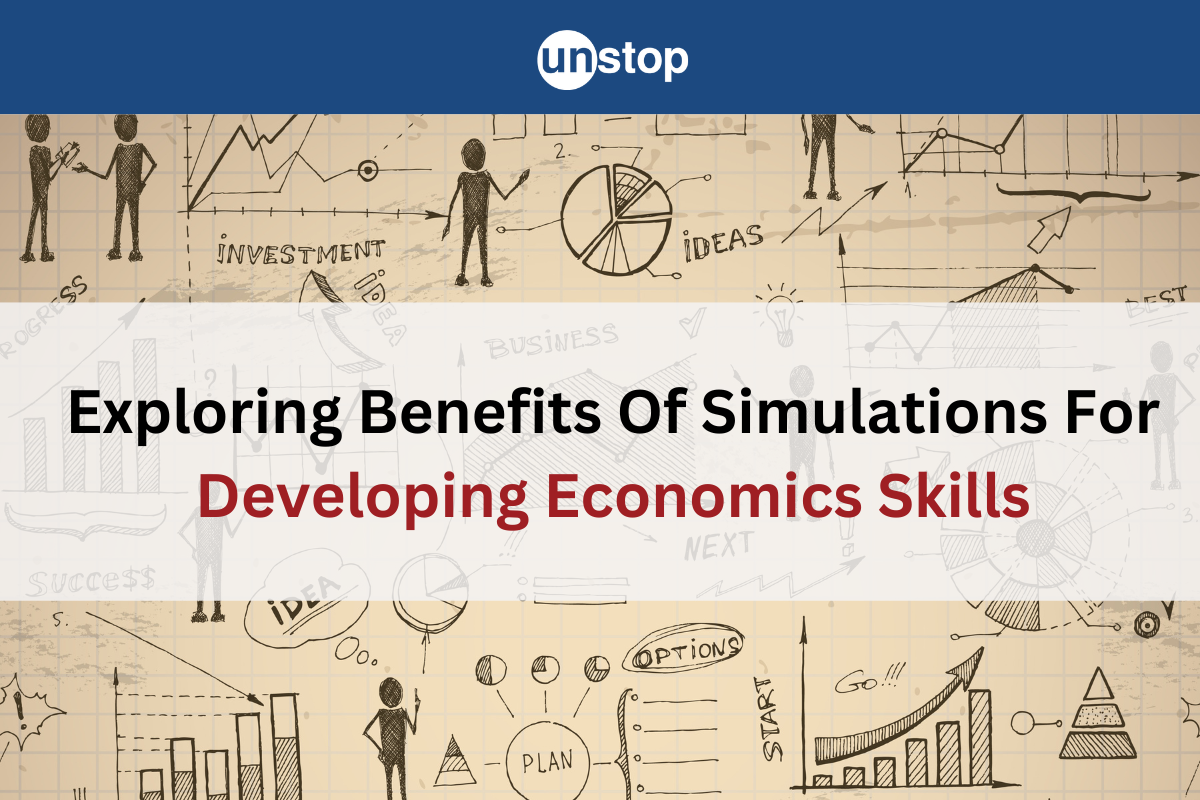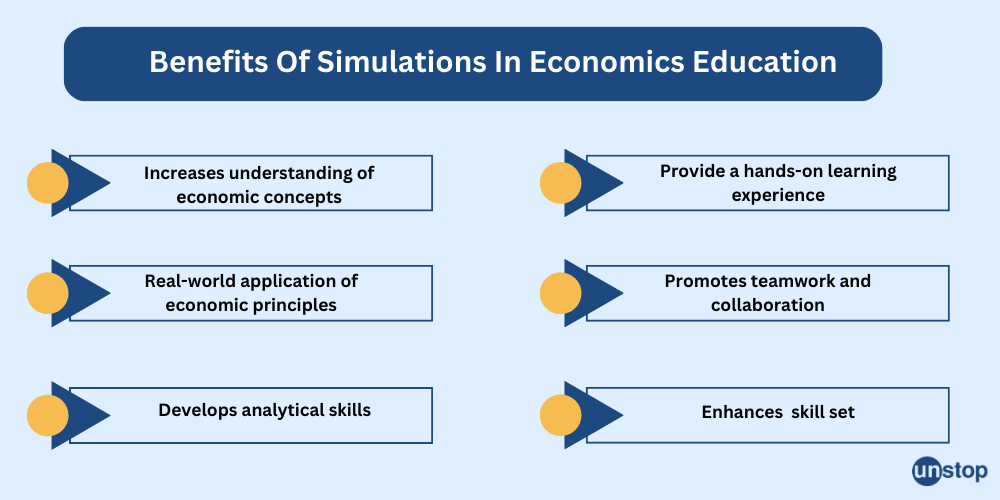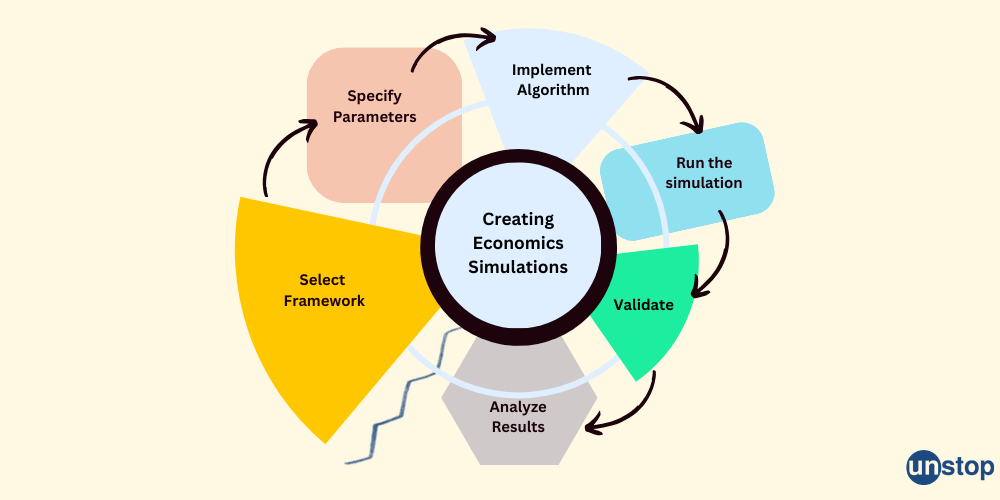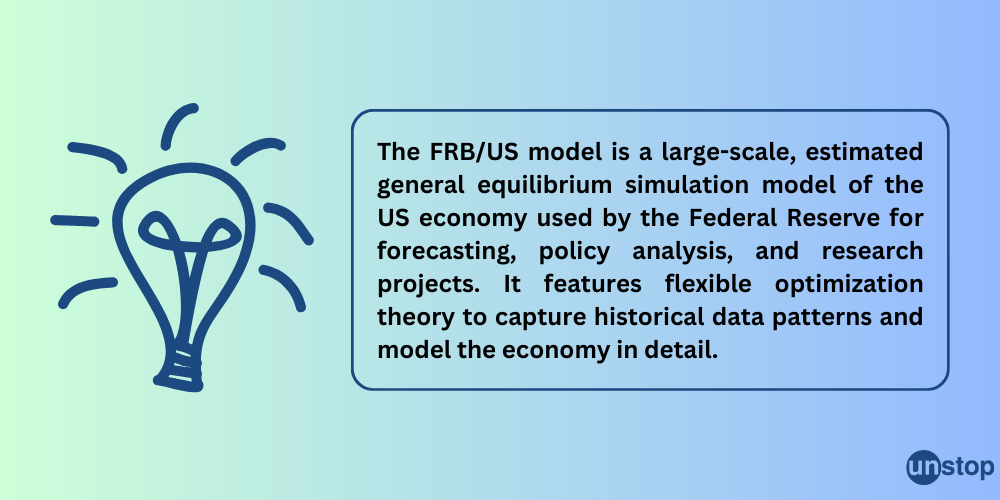- Economics Simulations For Developing Skills Among Students/Employees
- How can you create economics simulations?
- The Essentials of Economics Simulations
- Economics Simulations Case Study: Federal Reserve's Monetary Policy
- Summing Up
How Simulations Help In Developing Economics Skills Among Students & Employees?

Economics simulations have become an invaluable tool for students and employees seeking to gain deeper insights into complex economic systems. By creating virtual environments that mimic real-world scenarios, these simulations allow researchers to investigate the characteristics and transmission of economic phenomena in a controlled setting.
In the following sections, we will understand how economics simulations have been helpful in applying economic theorie and discuss their impact on improving our understanding of economic phenomena. We will also delve into a specific economics simulations case study for better understanding. So, let's dive in!
Train through real-world simulations! Check out this link for details
Economics Simulations For Developing Skills Among Students/Employees
Simulations can be a valuable tool in developing economics skills among students and employees. By providing a virtual environment that mimics real-world economic scenarios, simulations allow learners to apply economic concepts and principles in a practical and interactive way. Let’s see how economic simulations prove to be helpful for students and employees.
Benefits of Economics Simulations for Students
One of the key benefits of economics simulations is that they promote critical thinking and problem-solving skills. By participating in these simulations, students are challenged to analyze complex economic scenarios, make decisions based on limited information, and evaluate the outcomes of their choices. This process helps them develop their analytical skills and learn how to think strategically.
In addition to critical thinking skills, economics simulations also foster collaboration and teamwork. Many simulations are designed to be played in groups, requiring students to work together to achieve common goals. This collaborative environment encourages communication, negotiation, and compromise, all of which are important skills for success in the field of economics.
Furthermore, economics simulations provide a safe space for students to make mistakes and learn from them. In a simulation, students can experiment with different strategies and observe the consequences of their actions without real-world consequences. This trial-and-error approach allows students to develop their decision-making skills and learn from their failures, ultimately improving their ability to make informed choices in real-life economic situations.
Moreover, economics simulations offer a dynamic and interactive learning experience. Unlike traditional lectures or textbook readings, simulations actively engage students in the learning process. Students become active participants in their own education as they navigate through simulated economic scenarios, make decisions, and experience the consequences of those decisions in real time. This interactive approach not only enhances student engagement but also deepens their understanding of economic concepts and their practical applications.
Time to upgrade your skills? Ease it out with Unstop Pro! Check out this link
Benefits of Economics Simulations for Employees
Economics simulations are a valuable tool for developing skills among employees. These simulations provide a hands-on learning experience that allows employees to practice and refine their economic knowledge and decision-making abilities. By simulating real-world scenarios, employees can gain a better understanding of how economic principles and concepts apply to their work environment.
One key benefit of economics simulations is that they allow employees to make decisions and see the immediate consequences of those decisions. For example, in a simulation where employees must manage a virtual company, they can make decisions about pricing, production levels, and resource allocation. They can then see how these decisions impact their company's profitability and overall success.
Furthermore, economics simulations can help employees develop a deeper understanding of economic concepts and theories. Rather than simply reading about supply and demand or market equilibrium, employees can actively engage with these concepts in a simulated environment. Employees learn how to negotiate, compromise, and make collective decisions, which are valuable skills for any workplace.
Economics simulations are an effective tool for developing skills among employees. By participating in these simulations, employees can enhance their critical thinking, decision-making, collaboration, and problem-solving skills, all of which are valuable in the workplace.

Case Study: Economics Simulations Through An Employee's Eyes
Employee: Sarah, Data Analyst
Background: Sarah works at ABC Solutions, a rapidly growing company in the renewable energy sector. As a data analyst, she plays a crucial role in analyzing market trends and identifying opportunities for expansion. Recently, ABC Solutions was considering a major investment in a new solar panel manufacturing facility.
The Challenge: Sarah was tasked with evaluating the economic feasibility of the new facility. This involved analyzing a complex economic simulation that modeled the potential impact of the investment on the company's finances, market share, and workforce.
Sarah's Perspective: Sarah felt overwhelmed by the simulation. It was incredibly detailed and involved numerous variables that she wasn't familiar with. However, as she delved deeper, Sarah began to understand the power of simulation. She could see how different assumptions about market demand, production costs, and government subsidies could drastically affect the project's profitability.
The simulation allowed Sarah to explore various ‘what-if’ scenarios. For example, she could analyze how a potential change in government policy would impact the project's viability. This gave her a broader perspective and helped her identify potential risks and opportunities that could have been easily missed with traditional analysis methods.
Benefits:
- Enhanced decision-making: The simulation provided valuable insights that helped Sarah make informed recommendations to the management about the feasibility of the new facility.
- Improved collaboration: Working with the simulation team required Sarah to collaborate with colleagues from finance, marketing, and engineering departments. This fostered interdepartmental communication and a more holistic understanding of the project.
- Increased knowledge and skills: Sarah gained valuable experience in applying economic simulations to real-world business problems. This enhanced her skill set and made her a more valuable asset to the team.
Challenges:
- Data accuracy: Sarah recognized the importance of using accurate data in the simulation. She had to work closely with various departments to ensure the data was reliable and consistent.
- Model complexity: The initial complexity of the simulation presented a learning curve. Sarah had to invest time and effort to understand the model's underlying mechanisms and adjust it to address the company's specific needs.
- Uncertainty: The simulation was based on assumptions about future market conditions, which are inherently uncertain. Sarah had to communicate these uncertainties to the management and consider various scenarios in her analysis.
Outcome: Sarah's analysis, informed by the economic simulation, played a crucial role in ABC Solutions' decision-making. The company ultimately decided to proceed with the investment in the new solar panel manufacturing facility, which has since become a significant contributor to the company's growth and profitability.
How can you create economics simulations?
Creating economic simulations involves designing models that mimic real-world economic systems. This can be done by defining variables, equations, and rules that govern the behavior of agents (consumers, firms, markets, or governments) in the simulation.

Here is a general overview of the steps involved in creating economic simulations:
- Define the scope and objectives of the simulation: Clearly identify the economic problem or phenomenon you want to study and the specific questions you want to answer.
- Choose a framework: Select an appropriate modeling framework, such as agent-based modeling, macro-econometric modeling, or general equilibrium modeling. Each framework has its own strengths and weaknesses, so the choice will depend on the specific research question and the complexity of the economic system being studied.
- Specify the parameters: Define the variables and parameters that will be used in the simulation. These parameters represent the economic relationships and behavioral rules that govern the system.
- Implement the algorithm: Develop the computer code that will implement the simulation algorithm. This code will determine how the model evolves over time and how agents interact with each other.
- Run the simulation: Execute the simulation code and collect the results. This may involve running the simulation multiple times under different parameter settings or scenarios.
- Validate the simulation: Compare the results of the simulation to real-world data to assess the validity of the model. This may involve statistical tests, graphical comparisons, or case studies.
- Analyze and interpret the results: Draw conclusions from the simulation results and use them to answer the original research questions. This may involve identifying trends, patterns, or causal relationships.
- Communicate the findings: Present the simulation results and conclusions in a clear and concise way, using appropriate charts, graphs, and tables.
The Essentials of Economics Simulations
Monte Carlo Simulations
Monte Carlo simulations are a powerful tool for understanding complex systems and making informed decisions. For students and employees across various fields, Monte Carlo simulations can be helpful in the following ways:
For Students:
- Visually Understanding Concepts: Monte Carlo simulations can help students visualize abstract concepts and relationships in a way that traditional methods cannot. By seeing how different factors interact and influence outcomes, students can gain a deeper understanding of the underlying principles.
- Developing Problem-Solving Skills: Creating and running Monte Carlo simulations requires students to think critically and develop problem-solving skills. They need to identify key variables, define relationships, and analyze results, which helps them develop valuable analytical and quantitative reasoning skills.
- Exploring Uncertainty and Risk: Real-world situations often involve uncertainty and risk. Monte Carlo simulations allow students to explore the potential range of outcomes under different scenarios, helping them understand how various factors can affect the outcome and make better decisions in uncertain environments.
- Interactive Learning: Monte Carlo simulations can be used to create interactive learning environments where students can actively explore concepts and experiment with different variables. This can be a more engaging and effective way to learn than traditional lectures and textbook reading.
- Developing Programming Skills: Implementing Monte Carlo simulations often requires some programming skills. This can be a valuable opportunity for students to learn programming languages like Python or R, which are becoming increasingly important in various fields.
For Employees:
- Risk Assessment and Management: Monte Carlo simulations are widely used in business and finance to assess risk and manage uncertainty. By simulating different scenarios, employees can identify potential risks and develop strategies to mitigate them. This can help businesses make better investment decisions, optimize resource allocation, and improve financial performance.
- Project Planning and Decision Making: Monte Carlo simulations can be used to estimate project timelines, costs, and resource requirements. This can help employees plan projects more effectively, identify potential challenges, and make informed decisions about project execution.
- Improving Communication and Collaboration: Creating and analyzing Monte Carlo simulations often require collaboration between individuals from different disciplines. This can help employees develop better communication skills and learn to work effectively in teams.
- Continuing Education and Professional Development: Monte Carlo simulations are a valuable tool for staying up-to-date with the latest trends and advancements in various fields. By learning how to use these simulations, employees can expand their knowledge base and develop new skills that can benefit their careers.
- Enhancing Creativity and Innovation: Monte Carlo simulations can help employees think outside the box and explore new ideas. By simulating different scenarios and possibilities, they can identify innovative solutions to problems and develop creative approaches to challenges.
Behavioral Economics Theory in Simulations
Behavioral Economics Theory (BET) in simulations offers a unique and powerful way to gain a deeper understanding of human behavior and its impact on complex systems. This can lead to improved decision-making, policy design, and social impact across various fields. Here are some key benefits:
Increased Realism
- Most economic models assume rational decision-making, which can lead to unrealistic simulations. BET incorporates real-world human behavior, including emotions, biases, and heuristics, making simulations more accurate and predictive.
- This leads to more realistic outcomes, allowing for better testing of policies and interventions and improved understanding of real-world economic phenomena.
Improved Policy Design
- By understanding how individuals actually make decisions, policymakers can design more effective interventions and regulations.
- For example, simulations can be used to test different nudges or incentives to encourage desired behaviors, such as saving for retirement or reducing energy consumption.
Enhanced Market Analysis
- BET can help businesses understand how consumers make purchasing decisions, allowing them to develop more effective marketing strategies and product designs.
- Simulations can be used to test different pricing strategies, advertising campaigns, and product features to see how they impact consumer behavior.
Effective Risk Management
- BET can help identify and understand human biases that can lead to financial risks.
- Simulations can be used to stress-test institutions and financial systems to see how they would respond to different economic shocks, such as recessions or market crashes.
Better Resource Allocation
- By understanding how individuals respond to incentives, organizations can allocate resources more efficiently.
- For example, simulations can be used to optimize resource allocation in education, healthcare, and other public services.
Improved Social Impact
- BET can help design interventions to promote social good and address societal challenges.
- Simulations can be used to test different policies and programs aimed at reducing poverty, improving health outcomes, and promoting environmental sustainability.
Enhanced Predictive Power
- By incorporating human behavior into models, simulations can provide more accurate forecasts of economic trends and events.
- This allows for better planning and decision-making across various economic sectors.
Increased Transparency and Accountability
- By making the assumptions and biases of models explicit, BET can help to increase transparency and accountability in policymaking.
- This allows for more open and informed debate about the potential impacts of different policies and interventions.
Bayesian Statistics in Economic Modeling
Bayesian statistics provide a flexible framework for incorporating prior knowledge into economic models. Unlike traditional statistical methods that rely solely on observed data, Bayesian methods allow economists to incorporate existing information or beliefs about an economic system into their models. This integration of prior knowledge with new data enables economists to update probabilities as new information becomes available, resulting in more accurate predictions and robust decision-making.
Bayesian statistics offers a powerful and flexible approach to economic modeling, providing several advantages over traditional frequentist methods. Here are some:
Incorporation of Prior Information
- Unlike frequentist methods, Bayesian statistics allows for the incorporation of prior information and beliefs into the model. This can be particularly useful when dealing with small datasets or when there is significant uncertainty about the model parameters.
- This can lead to more accurate and precise estimates of model parameters, as prior information can help to guide the estimation process and reduce the impact of sampling error.
Estimation of Uncertainty
- Bayesian statistics provides a natural framework for estimating uncertainty in model parameters and predictions. This is done through the calculation of posterior probabilities, which represent the probability of a parameter value given the observed data and prior information.
- This allows for a more realistic and informative assessment of model uncertainty, which can be helpful for decision-making and policy analysis.
Model Comparison and Selection
- Bayesian statistics offers a powerful framework for comparing and selecting between different models. This is done through the calculation of Bayes factors, which represent the ratio of the marginal likelihoods of two models.
- This allows for a more objective and data-driven approach to model selection, as it avoids the need for arbitrary criteria like p-values.
Dynamic Modeling
- Bayesian statistics is well-suited for modeling dynamic systems, where the current state of the system depends on its past states. This is due to the recursive nature of Bayesian inference, which allows for the updating of posterior probabilities as new data becomes available.
- This makes Bayesian statistics ideal for modeling economic phenomena that evolve over time, such as business cycles and financial markets.
Computational Efficiency
- With the advancement of computational tools and algorithms, Bayesian methods have become increasingly efficient and accessible. Markov chain Monte Carlo (MCMC) methods allow for efficient sampling from posterior distributions, even for complex models with many parameters.
- This has made Bayesian statistics a viable option for a wider range of economic modeling applications.
Here are some examples of how Bayesian statistics is being used in economic modeling:
- The Federal Reserve Bank of St. Louis uses Bayesian methods to forecast economic growth.
- The International Monetary Fund uses Bayesian methods to model the global economy.
- The World Bank uses Bayesian methods to evaluate the effectiveness of development programs.
- Academic researchers use Bayesian methods to study a wide range of economic phenomena, such as business cycles, financial markets, and labor markets.
Assess the economic prowess of the candidates! Explore here
Economics Simulations Case Study: Federal Reserve's Monetary Policy
Background
The Federal Reserve (Fed) plays a crucial role in managing the U.S. economy. One of its primary tools is monetary policy, which involves adjusting interest rates and the money supply to influence economic growth, inflation, and unemployment. Determining the optimal level of interest rates is a complex challenge, and the Fed relies heavily on economic simulations to guide its policy decisions.
Challenge
In 2021, the U.S. economy was facing a unique challenge. The COVID-19 pandemic had caused significant economic disruption, with high unemployment and falling output. However, inflation was also rising, fueled by supply chain disruptions and government stimulus programs.
The Fed faced a difficult decision: raise interest rates to combat inflation or keep them low to support economic recovery.
Simulation
The Fed utilized a sophisticated economic simulation model known as FRB/US.

This model is a large-scale, dynamic general equilibrium model that incorporates various economic factors, including:
- Consumer behavior
- Business investment
- Government spending
- Monetary policy
- International trade
The model allows the Fed to simulate the potential effects of different interest rate settings on key economic indicators like GDP, inflation, and unemployment.
Process
The Fed economists used the FRB/US model to evaluate numerous scenarios. They varied interest rates by different amounts and observed the model's predictions for various economic outcomes. This allowed them to identify the potential trade-offs between controlling inflation and supporting economic growth.
Outcome
Based on the simulation results, the Fed decided to gradually increase interest rates starting in late 2021. This decision was informed by the model's prediction that gradually rising interest rates would help control inflation without causing a significant economic slowdown.
Benefits
- Improved decision-making: The economic simulation provided valuable insights that helped the Fed make informed decisions about monetary policy.
- Enhanced risk assessment: The simulation allowed the Fed to assess the potential risks and benefits of different policy options.
- Increased transparency: The Fed published summaries of its simulation results, enhancing transparency and public understanding of its policy decisions.
Challenges
- Model limitations: The FRB/US model is a complex and sophisticated tool, but it is still a simplification of the real-world economy. It is important to be aware of the model's limitations and interpret its results with caution.
- Data uncertainty: The model relies on economic data, which is inherently uncertain. The Fed addressed this challenge by using a range of data sources and conducting sensitivity analysis to assess the impact of different assumptions.
- Communication challenges: Communicating complex economic information to the public can be challenging. The Fed used various communication tools, including press conferences and speeches, to explain its policy decisions and the role of economic simulations.
Conclusion
The case of the Fed's use of economic simulations during the COVID-19 pandemic highlights the importance of this tool in guiding monetary policy decisions. By simulating potential economic outcomes, policymakers can make more informed choices and mitigate potential risks. However, it is crucial to recognize the limitations of such models and interpret their results with caution. As economic models continue to evolve, they will likely become even more valuable tools for policymakers navigating the complexities of the global economy.
Summing Up
Economic simulations offer a virtual laboratory for exploring complex economic phenomena. By modeling the interactions between economic agents and institutions, researchers and policymakers can analyze the potential outcomes of different policies and economic shocks. This allows them to:
- Test the effectiveness of proposed policies like tax reforms or monetary interventions.
- Understand how economic systems react to external shocks like pandemics or natural disasters.
- Explore alternative scenarios and assess potential risks and opportunities.
- Develop a deeper understanding of economic theory by applying models to real-world situations.
While powerful, economic simulations must be used with caution. Their accuracy depends on the model's quality, data used, and assumptions made. Addressing uncertainty through sensitivity analysis and incorporating probabilistic data helps create more robust simulations. Ultimately, economic simulations are valuable tools for informed decision-making but should be interpreted with awareness of their limitations.
Yearning for more? Here are some additional resources:
As a biotechnologist-turned-writer, I love turning complex ideas into meaningful stories that inform and inspire. Outside of writing, I enjoy cooking, reading, and travelling, each giving me fresh perspectives and inspiration for my work.
Login to continue reading
And access exclusive content, personalized recommendations, and career-boosting opportunities.
Subscribe
to our newsletter
Blogs you need to hog!

Organize Hackathons: The Ultimate Playbook With Past Case Studies

What is Campus Recruitment? How To Tap The Untapped Talent?

Lateral Hiring: A Complete Guide To The Process, Its Benefits, Challenges & Best Practices













Comments
Add comment